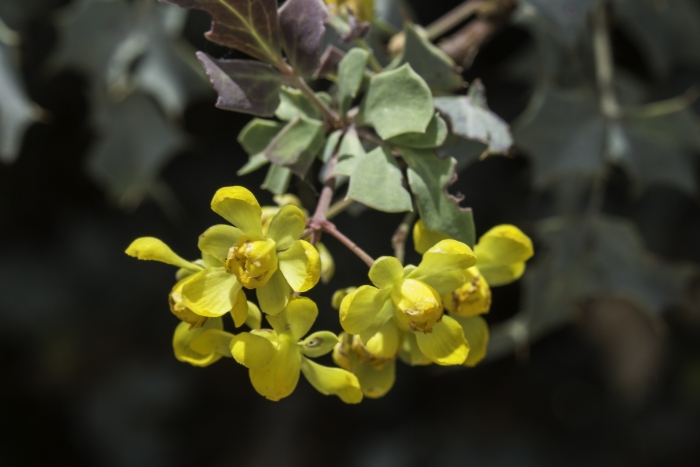Red Barberry
(Alloberberis haematocarpa)
Red Barberry (Alloberberis haematocarpa)
/
/

Craig Martin
Public Domain
Image By:
Craig Martin
Recorded By:
Copyright:
Public Domain
Copyright Notice:
Photo by: Craig Martin | License Type: Public Domain | License URL: http://creativecommons.org/publicdomain/zero/1.0/ | Rights Holder: Craig Martin | Publisher: iNaturalist | Date Created: 2021-04-23T13:50:11-07:00 |



















































Estimated Native Range
Summary
Alloberberis haematocarpa, commonly known as Red Barberry, is an evergreen shrub native to arid regions, including desert washes, chaparral, and scrublands of the Southwestern USA and Northern Mexico. It can reach a height of 3–4 meters (9.8–13.1 feet) with stiff, erect branches that may form a dense thicket. The plant is notable for its inflorescences, which bear clusters of 3 to 5 bright yellow flowers. Each flower has nine sepals and six petals arranged in whorls of three, blooming from February to June. The fruit is a juicy, edible berry that ripens to a deep red or purplish-red, attracting various birds and wildlife.
Red Barberry is valued for its drought tolerance and vibrant yellow flowers, which can add color to water-wise gardens. It is suitable for use as a natural barrier or hedge due to its thorny branches and dense growth habit. This shrub thrives in full sun to part shade and prefers well-drained soils, tolerating a range of soil types from sandy to loamy. While it requires low to medium water once established, it is important to avoid overwatering to prevent root rot. Red Barberry can be susceptible to fungal diseases in overly moist conditions. Gardeners should be aware of its potential to spread if conditions are favorable, and it may require management to prevent unwanted naturalization outside its native range.CC BY-SA 4.0
Red Barberry is valued for its drought tolerance and vibrant yellow flowers, which can add color to water-wise gardens. It is suitable for use as a natural barrier or hedge due to its thorny branches and dense growth habit. This shrub thrives in full sun to part shade and prefers well-drained soils, tolerating a range of soil types from sandy to loamy. While it requires low to medium water once established, it is important to avoid overwatering to prevent root rot. Red Barberry can be susceptible to fungal diseases in overly moist conditions. Gardeners should be aware of its potential to spread if conditions are favorable, and it may require management to prevent unwanted naturalization outside its native range.CC BY-SA 4.0
Plant Description
- Plant Type: Shrub
- Height: 3-8 feet
- Width: 3-8 feet
- Growth Rate: Moderate
- Flower Color: Yellow
- Flowering Season: Spring, Summer
- Leaf Retention: Evergreen
Growth Requirements
- Sun: Full Sun, Part Shade
- Water: Low, Medium
- Drainage: Medium
Common Uses
Bee Garden, Bird Garden, Deer Resistant, Low Maintenance, Showy Flowers
Natural Habitat
Native to arid regions, including desert washes, chaparral, and scrublands in the Southwestern USA and Northern Mexico
Other Names
Common Names: Red Mexican Barbery, Colorado Barberry, Mexican Barberry
Scientific Names: , Mahonia haematocarpa, Berberis haematocarpa, Alloberberis haematocarpa, Berberis nevinii var. haematocarpa, Berberis hoematocarpa, Berberis nevinii subsp. haematocarpa, Odostemon haematocarpus,
GBIF Accepted Name: Alloberberis haematocarpa (Wooton) C.C.Yu & K.F.Chung